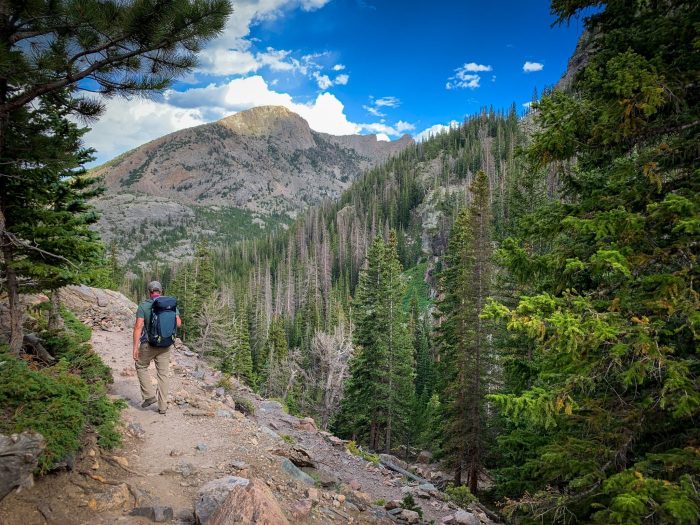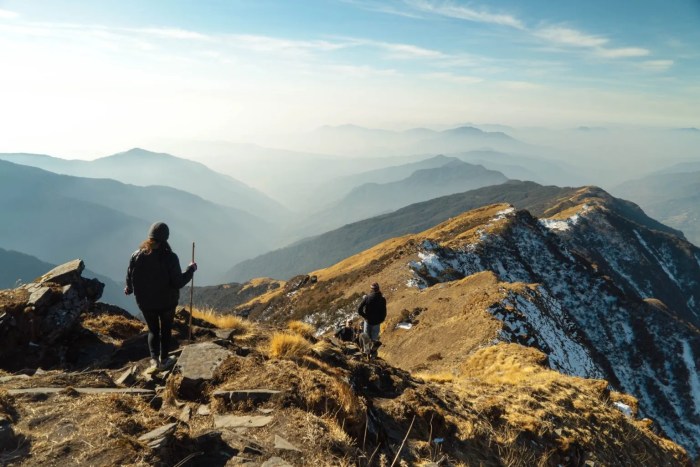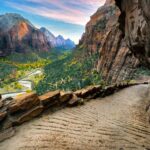Hiking Mountain Trails: Conquer majestic peaks and breathtaking vistas with our comprehensive guide. From choosing the right trail based on your skill level to mastering essential navigation techniques and prioritizing safety, we’ll equip you with everything you need for an unforgettable adventure. This isn’t just about reaching the summit; it’s about the journey, the challenges overcome, and the stunning landscapes you’ll witness along the way.
We’ll cover everything from essential gear and safety precautions to minimizing your environmental impact and capturing breathtaking photos. Prepare for an immersive experience that will transform your understanding of mountain hiking.
This guide delves into the intricacies of planning a successful mountain hike, encompassing route selection, permit acquisition, and weather forecasting. We’ll also explore various navigation methods, wildlife encounters, and the crucial importance of Leave No Trace principles. By the end, you’ll be confident in your ability to plan, execute, and enjoy a safe and responsible mountain hiking experience.
Get ready to elevate your hiking game.
Hiking Mountain Trail Difficulty Levels
Choosing the right mountain trail is crucial for a safe and enjoyable hiking experience. Underestimating the difficulty can lead to exhaustion, injury, or even dangerous situations. Conversely, overestimating your capabilities can lead to boredom and a less fulfilling adventure. Understanding the different difficulty levels is paramount to selecting a trail that matches your fitness level and experience.
Mountain Trail Difficulty Levels and Their Characteristics
Mountain trails are generally categorized into four difficulty levels: easy, moderate, difficult, and expert. These classifications consider factors like elevation gain, terrain type, trail length, and overall navigational challenges. Choosing a trail appropriate to your abilities is key to a successful hike.
| Difficulty Level | Terrain Description | Estimated Hiking Time | Required Fitness Level |
|---|---|---|---|
| Easy | Generally flat or gently rolling terrain with well-maintained trails. Minimal elevation gain. | 1-3 hours | Beginner; minimal prior hiking experience needed. |
| Moderate | Some elevation gain and potentially uneven terrain. Trails may be moderately well-maintained. May include some rocky sections or minor obstacles. | 3-6 hours | Intermediate; some hiking experience and reasonable fitness level required. |
| Difficult | Significant elevation gain, steep inclines, and potentially rough or rocky terrain. Trails may be less well-maintained or require some scrambling. | 6-10 hours or more | Advanced; significant hiking experience and high level of fitness required. Experience with navigation and potentially basic wilderness survival skills recommended. |
| Expert | Extreme elevation gain, very challenging terrain, potentially including exposure to heights, significant scrambling, and navigation challenges. May require specialized equipment and experience in technical mountaineering. | 10+ hours, often multi-day trips | Expert; extensive hiking and mountaineering experience, exceptional fitness, and specialized training are essential. This level often involves technical climbing and glacier travel. |
Activities Suitable for Each Difficulty Level
The activities suitable for each level directly correlate to the physical demands and technical skills required.Easy trails are perfect for leisurely nature walks, family outings, and introducing beginners to hiking. Imagine a stroll through a park with gentle inclines, suitable for pushing a stroller or bringing young children.Moderate trails are ideal for day hikes, exploring local scenic areas, and building stamina.
Think of a hike up a moderately challenging hill with rewarding views at the top.Difficult trails are best suited for experienced hikers seeking a challenging workout and rewarding views. These could involve longer hikes with significant elevation gain, possibly requiring navigation skills and preparedness for changing weather conditions. A classic example would be a strenuous hike to a mountain summit with significant elevation change.Expert trails are designed for experienced mountaineers and require specialized skills and equipment.
These often involve technical climbing, glacier travel, and overnight expeditions. A classic example would be climbing a challenging peak requiring ropes and ice axes.
Tips for Choosing a Trail Appropriate for Your Skill Level
Before embarking on any hike, it’s crucial to honestly assess your fitness level and experience. Research the trail thoroughly, paying close attention to elevation gain, trail length, terrain description, and reviews from other hikers. Start with easier trails to build your confidence and stamina before tackling more challenging ones. Always let someone know your hiking plans, including your intended route and estimated return time.
And finally, never underestimate the power of proper preparation, including adequate hydration, appropriate clothing, and essential gear.
Planning and Preparation for a Mountain Hike
Conquering a mountain trail isn’t just about physical strength; it’s about meticulous planning and preparation. A well-planned hike ensures safety, maximizes enjoyment, and minimizes the risk of unforeseen problems. Neglecting this crucial step can transform an exhilarating adventure into a potentially dangerous ordeal. This section will guide you through the essential steps to ensure your mountain hike is a resounding success.
Planning a successful mountain hike involves a multi-step process that considers your experience, fitness level, the chosen trail’s difficulty, and the prevailing weather conditions. Failure to adequately prepare can lead to unexpected challenges, potentially compromising your safety and enjoyment. Let’s delve into the key aspects of pre-hike planning.
Route Selection and Trail Research
Choosing the right trail is paramount. Begin by honestly assessing your hiking experience and fitness level. Are you a seasoned hiker tackling challenging terrain, or a beginner embarking on your first mountain adventure? Websites like AllTrails and local hiking organizations provide detailed trail descriptions, including elevation gain, distance, difficulty ratings, and user reviews. Consider the trail’s length and elevation profile to ensure it aligns with your capabilities and available time.
For example, a beginner might opt for a shorter, less strenuous trail with minimal elevation gain, while an experienced hiker could tackle a longer, more challenging route. Always check recent reviews to identify any trail closures or hazards.
Obtaining Necessary Permits and Reservations
Many popular mountain trails require permits or reservations, especially during peak season. Check the managing agency’s website (national park service, forest service, etc.) well in advance to determine if permits are needed and to secure your spot. Failure to obtain the necessary permits can result in fines or even trail closures. For example, Yosemite National Park requires reservations for many popular trails, and these often sell out months in advance.
Planning ahead and securing permits is crucial for a smooth and legal hiking experience.
Checking Weather Forecasts and Conditions
Mountain weather can change rapidly and unpredictably. Consult multiple weather sources – including the National Weather Service and specialized mountain weather forecasts – before your hike and check for updates on the day of. Pay close attention to temperature, precipitation, wind, and potential hazards like lightning or snow. A sudden change in weather can significantly impact your hike’s safety and enjoyment.
For instance, a seemingly mild forecast can quickly turn severe at higher altitudes, making proper preparation essential. Packing appropriate clothing and gear is directly influenced by the accuracy of your weather assessment.
Creating a Sample One-Day Hike Itinerary
A well-structured itinerary ensures you stay on schedule and account for potential delays. Here’s an example for a moderate one-day hike:
| Time | Activity | Details |
|---|---|---|
| 7:00 AM | Trailhead Arrival & Preparation | Check gear, apply sunscreen, hydrate. |
| 7:30 AM – 11:30 AM | Hike to Summit | Allow for breaks and slower pace on steeper sections. |
| 11:30 AM – 12:30 PM | Summit Enjoyment & Lunch | Take in the views, have lunch, and rest. |
| 12:30 PM – 4:30 PM | Return Hike | Maintain a steady pace, accounting for potential fatigue. |
| 4:30 PM | Trailhead Departure | Review your hike, plan for future adventures. |
Remember, this is just a sample itinerary. Adjust the times based on the trail’s length, elevation gain, and your personal pace. Always build in extra time for unforeseen circumstances.
Mountain Trail Navigation Techniques
Navigating mountain trails safely and efficiently requires a multifaceted approach, combining traditional methods with modern technology. Understanding the strengths and weaknesses of each technique, along with recognizing potential errors, is crucial for a successful and safe hike. This section details various navigation methods and strategies to minimize risks.
Comparison of Navigation Methods
Choosing the right navigation method depends on factors like terrain complexity, weather conditions, and personal preference. Each approach offers unique advantages and disadvantages. Map and compass navigation, while requiring more skill, offers resilience against technological failures. GPS devices provide precise location data but rely on battery power and satellite signals, which can be unreliable in certain areas. Smartphone apps combine map data with GPS functionality, offering convenience but are susceptible to battery drain and signal loss, mirroring the limitations of standalone GPS devices.
Common Navigational Errors and Avoidance Strategies, Hiking Mountain Trails
Several common mistakes can lead to disorientation and potentially dangerous situations. Failing to properly orient a map, relying solely on a single navigation tool without redundancy, neglecting to regularly check one’s position, and ignoring changing weather conditions are all significant errors. To avoid these, hikers should always carry multiple navigation tools (map and compass, GPS, or smartphone app), cross-reference their position using different methods, regularly check their bearings and location against their planned route, and carefully monitor weather forecasts and conditions.
Furthermore, understanding the limitations of each device is critical; for example, GPS signals can be blocked by dense tree cover or steep terrain.
Topographic Map Interpretation and Trail Markings
Topographic maps provide a detailed representation of the terrain, including elevation changes, contours, and features like rivers and trails. Learning to interpret contour lines—which represent lines of equal elevation—is essential for understanding the terrain’s slope and identifying potential obstacles. Trail markings, such as blazes (painted markings on trees) and cairns (piles of rocks), provide visual cues to guide hikers along the designated path.
Understanding the meaning of different colors and symbols on the map, as well as the variations in trail markings across different regions, is critical for accurate navigation. For instance, a common trail marking in many areas might be a series of red blazes on trees, but the specific color and pattern can vary based on local regulations or trail maintenance practices.
Failing to properly identify and interpret these markings can easily lead to straying from the intended route.
Wildlife Encounters on Mountain Trails: Hiking Mountain Trails

Mountain trails offer breathtaking views and invigorating exercise, but they also share space with a variety of wildlife. Understanding the animals you might encounter and how to react is crucial for a safe and enjoyable hike. Ignoring wildlife safety can lead to unpleasant, even dangerous, situations. This section will equip you with the knowledge to navigate these encounters responsibly.
Common Wildlife Encounters and Appropriate Responses
Many animals inhabit mountain ecosystems. Deer, elk, and various birds are relatively common and generally pose little threat if given space. However, encounters with bears, mountain lions, or other potentially dangerous animals require a different approach. Knowing how to identify these animals and understanding their behavior is paramount. For example, a bear exhibiting defensive behavior – such as making loud noises, huffing, or standing on its hind legs – is clearly communicating its discomfort and the need for immediate retreat.
Similarly, a mountain lion stalking prey will display different body language than one feeling threatened. Recognizing these subtle cues can be the difference between a peaceful observation and a dangerous confrontation.
Maintaining Safe Distance and Avoiding Conflict
The best way to avoid conflict with wildlife is to maintain a safe distance. This distance varies depending on the animal, but a general rule of thumb is to stay at least 100 yards away from large animals like bears and mountain lions. Smaller animals, like deer or squirrels, still require a respectful distance to avoid startling them.
Never approach or feed wild animals; this habituates them to humans, increasing the likelihood of future conflicts. Always travel in groups, as animals are less likely to approach a larger group of people. Making noise while hiking, such as talking or singing, can also help alert animals to your presence and allow them to avoid you.
Reacting to Dangerous Animal Encounters
While most wildlife encounters are harmless, understanding how to react in a dangerous situation is vital. If confronted by a bear, for instance, make yourself appear large, raise your arms, and slowly back away. Never run, as this might trigger a chase response. If attacked, fight back aggressively using any available tools or weapons. Encountering a mountain lion requires a different approach.
Make eye contact, appear large, yell, and throw rocks or sticks. If attacked, fight back vigorously, aiming for the eyes and nose. Remember, your reaction should always prioritize your safety and survival. These are not definitive guides, but rather general principles; specific actions will depend on the animal and the circumstances. After any significant wildlife encounter, report the incident to the relevant authorities to help them track animal behavior and improve safety guidelines for future hikers.
Photography on Mountain Trails

Capturing the breathtaking beauty of mountain landscapes and the elusive grace of mountain wildlife requires a blend of technical skill and artistic vision. This section will explore techniques to elevate your mountain photography, transforming fleeting moments into lasting memories. We’ll delve into composition, lighting considerations, and specific camera settings to help you achieve stunning results.
Camera Settings for Varying Lighting Conditions
Mastering your camera’s settings is crucial for capturing the dynamic range of light found in mountain environments. From the harsh glare of midday sun to the soft, diffused light of dawn and dusk, understanding how to adjust your aperture, shutter speed, and ISO will dramatically impact the quality of your images. In bright sunlight, a smaller aperture (higher f-stop number, like f/16) increases depth of field, keeping both foreground and background sharp.
A faster shutter speed (1/500th of a second or faster) freezes motion, ideal for capturing wildlife. A lower ISO (like ISO 100) minimizes noise. Conversely, in low-light conditions, a wider aperture (lower f-stop number, like f/2.8) lets in more light, requiring a slower shutter speed (potentially needing a tripod for stability) and a higher ISO (like ISO 3200 or higher), accepting a potential increase in image noise.
Experimentation is key to finding the optimal balance for each unique lighting scenario.
Techniques for Capturing Stunning Photographs of Mountain Scenery and Wildlife
Successful mountain photography hinges on understanding composition and anticipating moments. For landscapes, the rule of thirds is invaluable; placing key elements off-center creates a more visually appealing image. Leading lines, such as winding trails or rivers, can draw the viewer’s eye into the scene. Consider using a wide-angle lens to capture the grandeur of the mountains, showcasing their scale and imposing presence.
For wildlife photography, patience is paramount. Use a telephoto lens to get closer to your subject without disturbing it. Anticipate their movements and be ready to capture spontaneous moments. Remember to respect wildlife and maintain a safe distance. A well-composed shot that respects the animal’s environment is far more valuable than a technically perfect image that disrupts the natural world.
Composing Images to Convey Scale and Beauty
Effectively conveying the scale and beauty of a mountain environment requires careful consideration of your composition. Including a human element, such as a hiker in the distance, can provide a sense of scale and emphasize the vastness of the landscape. Similarly, juxtaposing a small wildflower with a towering mountain can highlight the contrast and delicate beauty within the rugged environment.
Using depth of field effectively can also create a sense of depth and distance, drawing the viewer’s eye through the scene. A shallow depth of field, achieved with a wide aperture, can isolate a specific subject against a blurred background, while a deep depth of field, achieved with a narrow aperture, can keep both foreground and background in sharp focus, emphasizing the vastness of the scene.
So, are you ready to embark on your next mountain adventure? Remember, proper planning, preparation, and respect for the environment are key to a successful and fulfilling hiking experience. By following the guidelines and tips Artikeld in this guide, you can confidently tackle mountain trails of varying difficulty levels, capturing stunning memories and leaving only footprints behind. Embrace the challenge, conquer the heights, and revel in the unparalleled beauty of the mountains.
Your journey starts now.

